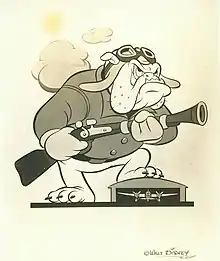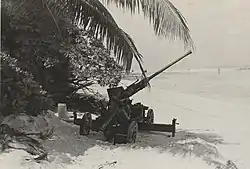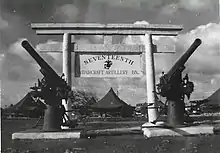17th Antiaircraft Artillery Battalion
The 17th Antiaircraft Artillery Battalion (17th AAA Bn) was an antiaircraft unit in the United States Marine Corps that served during World War II. The battalion was originally formed in 1942 as the 2d Airdrome Battalion and has the distinction of being the last defense battalion formed in the Marine Corps during the war. Its original mission was to provide air and coastal defense for advanced naval bases. During the war the battalion spent significant time defending Nukufetau and took part in combat operations at Tarawa and Tinian. The battalion was decommissioned on December 6, 1945.
2d Airdrome Battalion Table of Organization:[4]
- Headquarters and Service Battery
- Light tank platoon
- 90mm Gun Group
- 3 x 90mm Gun batteries
- Searchlight Batteries
- 2 x batteries each w/ six lights
- Special Weapons Group
- 40mm Battery (w/ 12 guns)
- 2 x machine gun platoons
| 17th Antiaircraft Artillery Battalion | |
|---|---|
 17th AAA Battalion insignia | |
| Active | |
| Country | |
| Branch | |
| Type | Air Defense/Coastal Defense |
| Size | ~1100 men |
| Nickname(s) | Two:Seventeen [3] |
| Motto(s) | "One of a Kind" [3] |
| Engagements | World War II |
| Commanders | |
| Current commander | N/A |
History
Organization
The 2d Airdrome Battalion was commissioned on October 28, 1942 at Camp Linda Vista, San Diego, California.[5] It was one of two airdrome battalions formed by the Marine Corps specifically to defend airfields in the China Burma India Theater. Those airfields were overrun by the Japanese before the battalions deployed so the Marine Corps quickly changed their tasking to missions in the Pacific Theater.[4]
The first thirteen men in the battalion came over from the 12th Defense Battalion joining the newly formed Headquarters and Service Battery under the authority of Area General Order 15-42.[5] While organizing and training in Southern California the battalion spent extensive time at Camp Callan, near La Jolla and Camp Dunlap in the Imperial Valley.[6] The 2d Airdrome Battalion departed the United States near the end of May 1943 onboard the USS Henderson (AP-1) and SS Cape Clear (AK-5039).[7]
The battalion arrived in Oahu, Hawaii on May 31, 1943. The battalion remained there for ten weeks of additional training as it waited for initial deployment orders. On August 14, 1943 the battalion embarked on the USS Ormsby (APA-49) and the SS Whistler and sailed west for the Ellice Islands.[7][8]
Nukefetau and Tarawa

Arriving at Funafuti on August 21, the 2d Airdrome Battalion only stayed a few days before moving to Nukufetau on August 25, 1943 along with the first elements of the Navy's 16th Naval Construction Battalion.[9] [10][7] Nukufetau was a small atoll 75 miles northwest of the airfield that had been established on Funafuti.[11] The battalion was responsible for air defense of the area while the Seabees constructed Nukufetau Airfield. The airfield was opened on October 6, 1943.[12]
Half of the 2d Airdrome Battalion was detached from duty on Nukufetau and sailed for Tarawa. The detachment went ashore four days after the 2nd Marine Division assaulted the beaches.[13] The remainder of the battalion departed Nukufetau in March 1944 after being relieved by elements of the 51st Defense Battalion. The 2d Airdrome Battalion sailed for Hawaii landing at Nawiliwili Harbor on March 21, 1944.[14]
Reorganization and Tinian
The 2d Airdrome Battalion was redesignated as the 17th Defense Battalion on March 22, 1944, and assigned to the V Amphibious Corps.[14] On April 19, 1944, it was again re-designated as the 17th Antiaircraft Battalion. In Hawaii the battalion trained for the occupation and defense of small islands in the Pacific. Between June 10–18 the battalion departed Hawaii in three echelons. The unit spent the next 54 days at sea enroute to its final objective.[14] While anchored in the harbor at Eniwetok on July 1,9 the battalion's moniker was changed for the final time, this time to the 17th Antiaircraft Artillery Battalion.[14]

The 17th Defense Battalion landed on Tinian on August 2, 1944. The battalion immediately established anti-aircraft positions north of the airfield and in the harbor. The 17th remained on occupation duty on Tinian for the next year. During this time, it conducted routine patrols and took a number of Japanese prisoners of war remaining on the island after the battle. Three Japanese aircraft bombed and strafed the island on November 3, 1944; however, the battalion's batteries were unable to successfully engage any of the aircraft. The battalion was guarding the airfield on August 6, 1945, when the Enola Gay launched to drop the first ever nuclear weapon against Hiroshima in mainland Japan. On August 15, 1945, the 17th Antiaircraft Artillery Battalion was relieved of its tactical duties on Tinian. It finally departed the island on November 1, 1945, on the USS Griggs (APA-110).[15] The battalion sailed back to the United States and was officially decommissioned on December 6, 1945, at Marine Corps Base Camp Pendleton, California.[2]
Gallery
 Coincidence rangefinder being utilized on Nukufetau on November 27, 1943.
Coincidence rangefinder being utilized on Nukufetau on November 27, 1943.
Unit awards
A unit citation or commendation is an award bestowed upon an organization for the action cited. Members of the unit who participated in said actions are allowed to wear on their uniforms the awarded unit citation. The 17th Antiaircraft Artillery Battalion has been presented with the following awards:
| Streamer | Award | Year(s) | Additional Info |
|---|---|---|---|
| Asiatic-Pacific Campaign Streamer | Tinian | ||
| World War II Victory Streamer | 1941–1945 | Pacific War |
Citations
- Rottman 2002, pp. 216.
- Rottman 2002, pp. 217.
- Melson 1996, pp. 32.
- Rottman 2002, pp. 215.
- Henry, Jr. 1985, pp. 39.
- Henry, Jr. 1985, pp. 41.
- Henry & Bartlett 1985, pp. 36.
- Henry, Jr. 1985, pp. 45.
- Henry, Jr. 1985, pp. 46.
- Crowl & Love 1993, pp. 52.
- Sherrod 1952, pp. 223.
- Bartlett 1986, pp. 63.
- Rottman 2004, pp. 54–55.
- Henry & Bartlett 1985, pp. 38.
- Henry & Bartlett 1985, pp. 38–39.
References
- Bibliography
- Crowl, Philip; Love, Edmund G. (1993). Seizure of the Gilberts and Marshalls. United States Army in World War II. Washington, D.C.: Center of Military History - United States Army.
- Henry, Jr., Charles L. (1985). One of a Kind. Memphis, Tennessee: Mercury Printing Company.
- Rottman, Gordon L. (2002). U.S. Marine Corps World War II Order of Battle: Ground and Air Units in the Pacific War, 1939–1945. Greenwood Press. ISBN 0-313-31906-5.
- Rottman, Gordon L. (2004). US Marine Corps Pacific Theater of Operations 1943-44. Osprey Press. ISBN 1-84176-651-8.
- Sherrod, Robert (1952). History of Marine Corps Aviation in World War II. Washington, D.C.: Combat Forces Press. ISBN 0-89201-048-7.
Journal
- Henry, Charles; Bartlett, Tom (1985). "One of a Kind". Leatherneck. LXVIII (6): 34–39.
- Bartlett, Tom (1986). "2d Airdrome/17th AAA Reunion". Leatherneck. LXIX (9): 62–63.
- Web
- Melson, Charles D. (1996). Condition Red: Marine Defense Battalions in World War II (PDF). Marines in World War II Commemorative Series. Washington, D.C.: Marine Corps Historical Center. LCCN 96174419. OCLC 34920984. Retrieved 2020-05-25. Part 2
- Further reading
- Henry Jr., Charles E. (1971) One Of A Kind: 2d Airdrome Battalion Fleet Marine Force United States Marine Corps Mercury Printing Company
